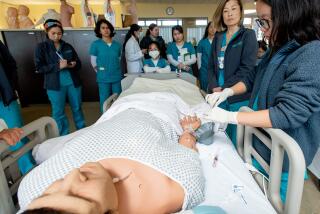Don’t Leave Out Community Colleges
A mechanic would never fix a transmission while leaving pistons cracked. A builder would never repair the foundation of a house and leave the roof leaking. A doctor would not treat an infected ear and overlook a sore throat. The mechanic, builder and doctor of California education, Gov. Gray Davis, while attending to the dire needs of our K-12 system should support the state Legislature’s conference committee recommendation to add an additional $56 million to California’s community colleges.
Voters in the Golden State strongly reaffirmed their deep-rooted commitment to education by electing Davis last year. On the campaign trail, Davis emphasized “education, education, education,” as his “first, second and third priorities.” The redemptive theme of education as the cornerstone for a society of opportunity, swept Davis and other pro-education candidates into office.
But the message has translated only so far into policy. Kindergarten through 12th grade, long underfunded and richly deserving of the rewards of a booming economy, should not be the ending point for progress in the governor’s May revision of the state budget.
At a time in history when the state enjoys a revenue surplus of $4.35 billion--enough for a $355-million cash allocation for a new prison, community colleges shouldn’t be in an educational lock down. The governor’s revised budget added only one-half of 1% of this huge surplus to community colleges, a system that serves 1.45 million students. Seventy percent of all undergraduate students attend a California community college. Eighty-four percent of all Latinos in college attend community colleges, and in the Los Angeles Community College District alone, three times more African American students are educated than at the nine University of California campuses combined. Because of the previous governors’ neglect, real funding is down 25% since 1978 and per-student funding is $2,000 below the national average for two-year colleges.
Are we to graduate approximately 300,000 high school seniors this month and abandon our commitment to providing affordable, quality higher education? Do we ignore the needs of such occupations as nursing and technology development, which depend on the community colleges for their next generation of employees? The obvious answer is a resounding no.
Community colleges took their lumps during the recession earlier this decade. Antiquated equipment remained in place and old buildings deteriorated further. An expected enrollment explosion caused by children of the baby boomers, dubbed “Tidal Wave II,” will bring nearly 500,000 more students into community colleges by 2005. California turned Tidal Wave I into the success story of a generation, with an open-door policy that resulted in millions who advanced their lives and helped fuel an economic boom. And according to the just-released report from the California Citizens Commission on Higher Education, community colleges are “underfunded in relation to their needs” and will only be prepared for the next century if additional resources are allocated.
We are faced with some critical questions at a defining moment in our history. Will we ensure opportunity for the next generation, the children of the middle class, the working poor and new immigrants? Will we keep the door open to higher education for those who need it the most? Or will a social and economic myopia relegate the dreams and aspirations of the young women and men who will inherit the future to the back seat of the education bus?
If the governor signs the budget as revised by the Legislature, an additional $5 million will be available for the Los Angeles Community College District. This will allow us to improve student services, hire full-time faculty, open hundreds of new classes, begin to repair our buildings and provide access to those who have the desire and will to attend college.
Community colleges are as vital today as when the education Master Plan was crafted in 1959. Let us hope that Davis will join the Legislature in its attempt to undo years of neglect. Our communities, our businesses and our students demand no less.
More to Read
Sign up for Essential California
The most important California stories and recommendations in your inbox every morning.
You may occasionally receive promotional content from the Los Angeles Times.










